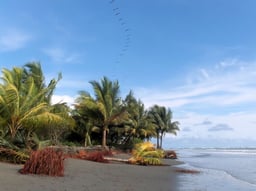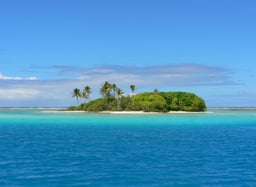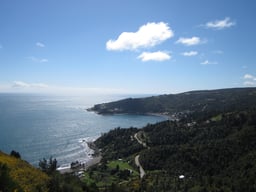Pacific Ocean
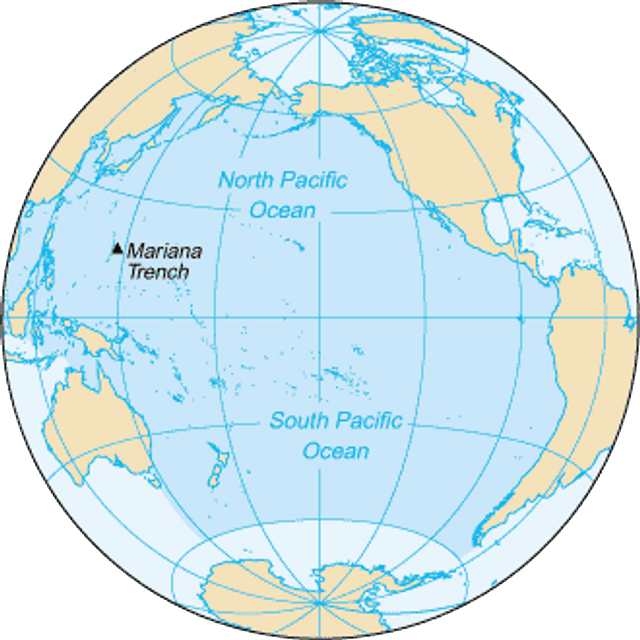
Pacific Ocean

| Pacific Ocean | |
|---|---|
| Surface area | 165,250,000 km(63,800,000 sq mi) |
| Average depth | 4,280 m (14,040 ft) |
| Max. depth | 10,911 m (35,797 ft) |
| Water volume | 710,000,000 km(170,000,000 cu mi) |
| Islands | List of islands |
| Settlements | Anchorage,Auckland,Astoria,Busan,Christchurch,Coos Bay,Guayaquil,Honolulu,Ilagan,Lima,Papeete,San Francisco,Seattle,Shanghai,Singapore,Sydney,Tijuana,Tokyo,Valparaíso Metro,Vancouver,Vladivostok |
The Pacific Ocean is the largest and deepest of Earth's oceanic divisions. It extends from the Arctic Ocean in the north to the Southern Ocean (or, depending on definition, to Antarctica) in the south and is bounded by Asia and Australia in the west and the Americas in the east.
At 165,250,000 square kilometers (63,800,000 square miles) in area (as defined with an Antarctic southern border), this largest division of the World Ocean—and, in turn, the hydrosphere—covers about 46% of Earth's water surface and about one-third of its total surface area, making it larger than all of Earth's land area combined.[1] The centers of both the Water Hemisphere and the Western Hemisphere are in the Pacific Ocean. The equator subdivides it into the North(ern) Pacific Ocean and South(ern) Pacific Ocean, with two exceptions: the Galápagos and Gilbert Islands, while straddling the equator, are deemed wholly within the South Pacific.[2] Its mean depth is 4,000 meters (13,000 feet).[3] The Mariana Trench in the western North Pacific is the deepest point in the world, reaching a depth of 10,911 meters (35,797 feet).[4] The western Pacific has many peripheral seas.
Though the peoples of Asia and Oceania have traveled the Pacific Ocean since prehistoric times, the eastern Pacific was first sighted by Europeans in the early 16th century when Spanish explorer Vasco Núñez de Balboa crossed the Isthmus of Panama in 1513 and discovered the great "southern sea" which he named Mar del Sur (in Spanish). The ocean's current name was coined by Portuguese explorer Ferdinand Magellan during the Spanish circumnavigation of the world in 1521, as he encountered favorable winds on reaching the ocean. He called it Mar Pacífico, which in both Portuguese and Spanish means "peaceful sea".[5]
| Pacific Ocean | |
|---|---|
| Surface area | 165,250,000 km(63,800,000 sq mi) |
| Average depth | 4,280 m (14,040 ft) |
| Max. depth | 10,911 m (35,797 ft) |
| Water volume | 710,000,000 km(170,000,000 cu mi) |
| Islands | List of islands |
| Settlements | Anchorage,Auckland,Astoria,Busan,Christchurch,Coos Bay,Guayaquil,Honolulu,Ilagan,Lima,Papeete,San Francisco,Seattle,Shanghai,Singapore,Sydney,Tijuana,Tokyo,Valparaíso Metro,Vancouver,Vladivostok |
History
Early migrations

Universalis Cosmographia, the Waldseemüller map dated 1507, from a time when the nature of the Americas was ambiguous, particularly North America, as a possible part of Asia, was the first map to show the Americas separating two distinct oceans. South America was generally considered a "new world" and shows the name "America" for the first time, after Amerigo Vespucci
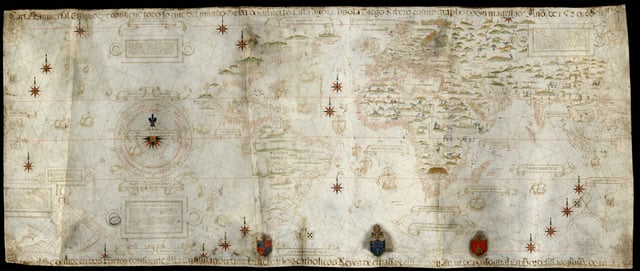
Made in 1529, the Diogo Ribeiro map was the first to show the Pacific at about its proper size
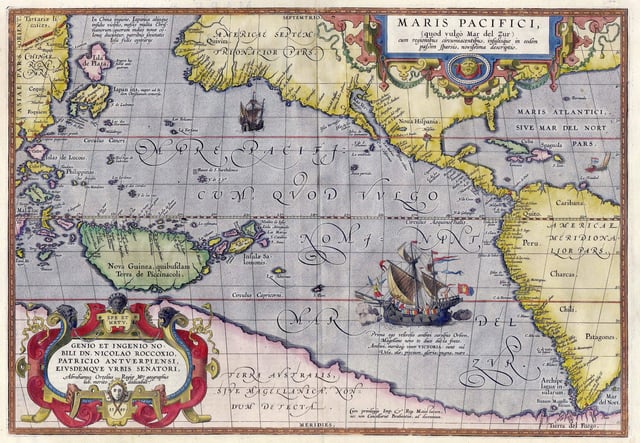
Maris Pacifici by Ortelius (1589). One of the first printed maps to show the Pacific Ocean[6]
Important human migrations occurred in the Pacific in prehistoric times.
About 3000 BC, the Austronesian peoples on the island of Taiwan mastered the art of long-distance canoe travel and spread themselves and their languages south to the Philippines, Indonesia, and maritime Southeast Asia; west towards Madagascar; southeast towards New Guinea and Melanesia (intermarrying with native Papuans); and east to the islands of Micronesia, Oceania and Polynesia.[7]
Long-distance trade developed all along the coast from Mozambique to Japan. Trade, and therefore knowledge, extended to the Indonesian islands but apparently not Australia. By at least 878 when there was a significant Islamic settlement in Canton much of this trade was controlled by Arabs or Muslims. In 219 BC Xu Fu sailed out into the Pacific searching for the elixir of immortality. From 1404 to 1433 Zheng He led expeditions into the Indian Ocean.
European exploration

Map of the Pacific Ocean during European Exploration, circa 1702–1707.

Map of the Pacific Ocean during European Exploration, circa 1754.

Spanish explorations and routes across the Pacific Ocean.
The first contact of European navigators with the western edge of the Pacific Ocean was made by the Portuguese expeditions of António de Abreu and Francisco Serrão, via the Lesser Sunda Islands, to the Maluku Islands, in 1512,[8][9] and with Jorge Álvares's expedition to southern China in 1513,[10] both ordered by Afonso de Albuquerque from Malacca.
The east side of the ocean was discovered by Spanish explorer Vasco Núñez de Balboa in 1513 after his expedition crossed the Isthmus of Panama and reached a new ocean.[11] He named it Mar del Sur (literally, "Sea of the South" or "South Sea") because the ocean was to the south of the coast of the isthmus where he first observed the Pacific.
In 1519, Portuguese explorer Ferdinand Magellan sailed the Pacific East to West on a Spanish expedition to the Spice Islands that would eventually result in the first world circumnavigation. Magellan called the ocean Pacífico (or "Pacific" meaning, "peaceful") because, after sailing through the stormy seas off Cape Horn, the expedition found calm waters. The ocean was often called the Sea of Magellan in his honor until the eighteenth century.[12] Magellan stopped at one uninhabited Pacific island before stopping at Guam in March 1521.[13] Although Magellan himself died in the Philippines in 1521, Spanish Basque navigator Juan Sebastián Elcano led the remains of the expedition back to Spain across the Indian Ocean and round the Cape of Good Hope, completing the first world circumnavigation in a single expedition in 1522.[14] Sailing around and east of the Moluccas, between 1525 and 1527, Portuguese expeditions discovered the Caroline Islands,[15] the Aru Islands,[16] and Papua New Guinea.[17] In 1542–43 the Portuguese also reached Japan.[18]
In 1564, five Spanish ships carrying 379 explorers crossed the ocean from Mexico led by Miguel López de Legazpi, and sailed to the Philippines and Mariana Islands.[19] For the remainder of the 16th century, Spanish influence was paramount, with ships sailing from Mexico and Peru across the Pacific Ocean to the Philippines via Guam, and establishing the Spanish East Indies. The Manila galleons operated for two and a half centuries, linking Manila and Acapulco, in one of the longest trade routes in history. Spanish expeditions also discovered Tuvalu, the Marquesas, the Cook Islands, the Solomon Islands, and the Admiralty Islands in the South Pacific.[20]
Later, in the quest for Terra Australis ("the [great] Southern Land"), Spanish explorations in the 17th century, such as the expedition led by the Portuguese navigator Pedro Fernandes de Queirós, discovered the Pitcairn and Vanuatu archipelagos, and sailed the Torres Strait between Australia and New Guinea, named after navigator Luís Vaz de Torres. Dutch explorers, sailing around southern Africa, also engaged in discovery and trade; Willem Janszoon, made the first completely documented European landing in Australia (1606), in Cape York Peninsula,[21] and Abel Janszoon Tasman circumnavigated and landed on parts of the Australian continental coast and discovered Tasmania and New Zealand in 1642.[22]
In the 16th and 17th centuries Spain considered the Pacific Ocean a mare clausum—a sea closed to other naval powers. As the only known entrance from the Atlantic, the Strait of Magellan was at times patrolled by fleets sent to prevent entrance of non-Spanish ships. On the western side of the Pacific Ocean the Dutch threatened the Spanish Philippines.[23]
The 18th century marked the beginning of major exploration by the Russians in Alaska and the Aleutian Islands, such as the First Kamchatka expedition and the Great Northern Expedition, led by the Danish Russian navy officer Vitus Bering. Spain also sent expeditions to the Pacific Northwest, reaching Vancouver Island in southern Canada, and Alaska. The French explored and settled Polynesia, and the British made three voyages with James Cook to the South Pacific and Australia, Hawaii, and the North American Pacific Northwest. In 1768, Pierre-Antoine Véron, a young astronomer accompanying Louis Antoine de Bougainville on his voyage of exploration, established the width of the Pacific with precision for the first time in history.[24] One of the earliest voyages of scientific exploration was organized by Spain in the Malaspina Expedition of 1789–1794. It sailed vast areas of the Pacific, from Cape Horn to Alaska, Guam and the Philippines, New Zealand, Australia, and the South Pacific.[20]
New Imperialism

The bathyscaphe Trieste, before her record dive to the bottom of the Mariana Trench, 23 January 1960
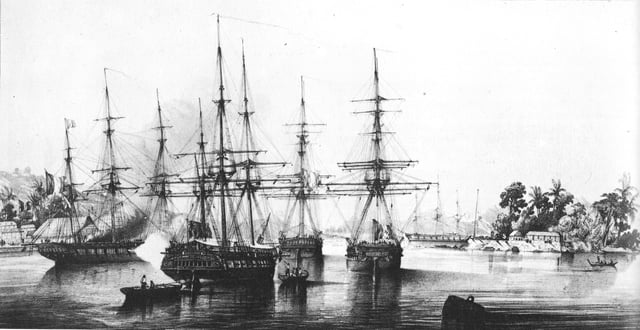
Dupetit Thouars taking over Tahiti on 9 September 1842
Growing imperialism during the 19th century resulted in the occupation of much of Oceania by European powers, and later Japan and the United States. Significant contributions to oceanographic knowledge were made by the voyages of HMS Beagle in the 1830s, with Charles Darwin aboard;[25] HMS Challenger during the 1870s;[26] the USS Tuscarora (1873–76);[27] and the German Gazelle (1874–76).[28]
In Oceania, France obtained a leading position as imperial power after making Tahiti and New Caledonia protectorates in 1842 and 1853 respectively.[29] After navy visits to Easter Island in 1875 and 1887, Chilean navy officer Policarpo Toro negotiated the incorporation of the island into Chile with native Rapanui in 1888. By occupying Easter Island, Chile joined the imperial nations.[30]Chile%20and%20the%20United%20States%3A%20Empir]][] By 1900 nearly all Pacific islands were in control of Britain, France, United States, Germany, Japan, and Chile.[[29]](https://openlibrary.org/search?q=Bernard%20Eccleston%2C%20Michael%20Dawson.%201998.%20 [[CITE|29|https://openlibrary.org/search?q=Bernard%20Eccleston%2C%20Michael%20Dawson.%201998.%20*The%20Asia)
Although the United States gained control of Guam and the Philippines from Spain in 1898,[31] Japan controlled most of the western Pacific by 1914 and occupied many other islands during World War II. However, by the end of that war, Japan was defeated and the U.S. Pacific Fleet was the virtual master of the ocean. The Japanese-ruled Northern Mariana Islands came under control of the United States.[32] Since the end of World War II, many former colonies in the Pacific have become independent states.
Geography
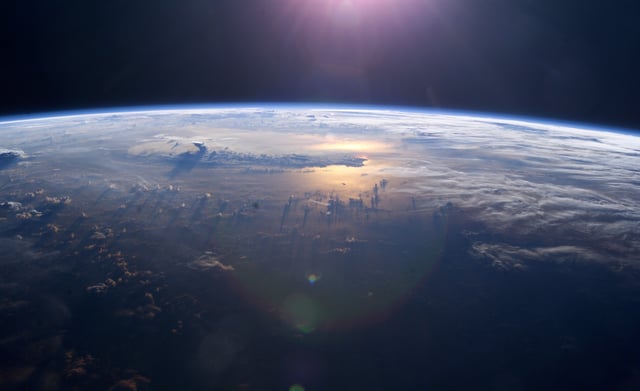
Sunset over the Pacific Ocean as seen from the International Space Station. Anvil tops of thunderclouds are also visible.
The Pacific separates Asia and Australia from the Americas.
It may be further subdivided by the equator into northern (North Pacific) and southern (South Pacific) portions.
It extends from the Antarctic region in the South to the Arctic in the north.[1] The Pacific Ocean encompasses approximately one-third of the Earth's surface, having an area of 165,200,000 km2 (63,800,000 sq mi)—significantly larger than Earth's entire landmass of some 150,000,000 km2 (58,000,000 sq mi).[33]
Extending approximately 15,500 km (9,600 mi) from the Bering Sea in the Arctic to the northern extent of the circumpolar Southern Ocean at 60°S (older definitions extend it to Antarctica's Ross Sea), the Pacific reaches its greatest east-west width at about 5°N latitude, where it stretches approximately 19,800 km (12,300 mi) from Indonesia to the coast of Colombia—halfway around the world, and more than five times the diameter of the Moon.[34] The lowest known point on Earth—the Mariana Trench—lies 10,911 m (35,797 ft; 5,966 fathoms) below sea level. Its average depth is 4,280 m (14,040 ft; 2,340 fathoms), putting the total water volume at roughly 710,000,000 km3 (170,000,000 cu mi).[1]
Due to the effects of plate tectonics, the Pacific Ocean is currently shrinking by roughly 2.5 cm (1 in) per year on three sides, roughly averaging 0.52 km2 (0.20 sq mi) a year. By contrast, the Atlantic Ocean is increasing in size.[35][36]
Along the Pacific Ocean's irregular western margins lie many seas, the largest of which are the Celebes Sea, Coral Sea, East China Sea (East Sea), Philippine Sea, Sea of Japan, South China Sea (South Sea), Sulu Sea, Tasman Sea, and Yellow Sea (West Sea of Korea). The Indonesian Seaway (including the Strait of Malacca and Torres Strait) joins the Pacific and the Indian Ocean to the west, and Drake Passage and the Strait of Magellan link the Pacific with the Atlantic Ocean on the east. To the north, the Bering Strait connects the Pacific with the Arctic Ocean.[2]
As the Pacific straddles the 180th meridian, the West Pacific (or western Pacific, near Asia) is in the Eastern Hemisphere, while the East Pacific (or eastern Pacific, near the Americas) is in the Western Hemisphere.[38]
The Southern Pacific Ocean harbors the Southeast Indian Ridge crossing from south of Australia turning into the Pacific-Antarctic Ridge (north of the South Pole) and merges with another ridge (south of South America) to form the East Pacific Rise which also connects with another ridge (south of North America) which overlooks the Juan de Fuca Ridge.
For most of Magellan's voyage from the Strait of Magellan to the Philippines, the explorer indeed found the ocean peaceful. However, the Pacific is not always peaceful. Many tropical storms batter the islands of the Pacific.[39] The lands around the Pacific Rim are full of volcanoes and often affected by earthquakes.[40] Tsunamis, caused by underwater earthquakes, have devastated many islands and in some cases destroyed entire towns.[41]
Bordering countries and territories
Sovereign nations
Australia
Brunei
Cambodia
Canada
Chile
China 1
Colombia
Ecuador
Federated States of Micronesia
Guatemala
Honduras
Indonesia
Kiribati
Nicaragua
Panama
Peru
Philippines
Russia
Singapore
Taiwan 1
Thailand
Tonga
Vanuatu
Vietnam
political status of Taiwan.
Territories
American Samoa (US)
Baker Island (US)
[[INLINE_IMAGE|//upload.wikimedia.org/wikipedia/en/thumb/c/c3/Flag_of_France.svg/23px-Flag_of_France.svg.png|//upload.wikimedia.org/wikipedia/en/thumb/c/c3/Flag_of_France.svg/35px-Flag_of_France.svg.png 1.5x, //upload.wikimedia.org/wikipedia/en/thumb/c/c3/Flag_of_France.svg/45px-Flag_of_France.svg.png 2x|France|h15|w23|thumbborder flagicon-img flagicon-img]] Clipperton Island (France)
Cook Islands (New Zealand)
Coral Sea Islands (Australia)
French Polynesia (France)
Guam (US)
Hong Kong (China)
Howland Island (US)
[[INLINE_IMAGE|//upload.wikimedia.org/wikipedia/en/thumb/a/a4/Flag_of_the_United_States.svg/23px-Flag_of_the_United_States.svg.png|//upload.wikimedia.org/wikipedia/en/thumb/a/a4/Flag_of_the_United_States.svg/35px-Flag_of_the_United_States.svg.png 1.5x, //upload.wikimedia.org/wikipedia/en/thumb/a/a4/Flag_of_the_United_States.svg/46px-Flag_of_the_United_States.svg.png 2x|United States|h12|w23|thumbborder flagicon-img flagicon-img]] Jarvis Island (US)
Johnston Island (US)
[[INLINE_IMAGE|//upload.wikimedia.org/wikipedia/en/thumb/a/a4/Flag_of_the_United_States.svg/23px-Flag_of_the_United_States.svg.png|//upload.wikimedia.org/wikipedia/en/thumb/a/a4/Flag_of_the_United_States.svg/35px-Flag_of_the_United_States.svg.png 1.5x, //upload.wikimedia.org/wikipedia/en/thumb/a/a4/Flag_of_the_United_States.svg/46px-Flag_of_the_United_States.svg.png 2x|United States|h12|w23|thumbborder flagicon-img flagicon-img]] Kingman Reef (US)
Macau (China)
Midway Atoll (US)
New Caledonia (France)
Niue (New Zealand)
Norfolk Island (Australia)
Palmyra Atoll (US)
Pitcairn Islands (UK)
Tokelau (New Zealand)
Wallis and Futuna (France)
Wake Island (US)
Landmasses and islands
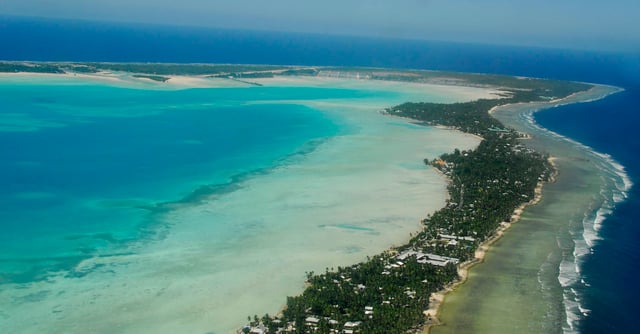
Tarawa Atoll in the Republic of Kiribati
This ocean has most of the islands in the world.
There are about 25,000 islands in the Pacific Ocean.[44][45][46] The islands entirely within the Pacific Ocean can be divided into three main groups known as Micronesia, Melanesia and Polynesia. Micronesia, which lies north of the equator and west of the International Date Line, includes the Mariana Islands in the northwest, the Caroline Islands in the center, the Marshall Islands to the east and the islands of Kiribati in the southeast.[47][48]
Melanesia, to the southwest, includes New Guinea, the world's second largest island after Greenland and by far the largest of the Pacific islands. The other main Melanesian groups from north to south are the Bismarck Archipelago, the Solomon Islands, Santa Cruz, Vanuatu, Fiji and New Caledonia.[49]
The largest area, Polynesia, stretching from Hawaii in the north to New Zealand in the south, also encompasses Tuvalu, Tokelau, Samoa, Tonga and the Kermadec Islands to the west, the Cook Islands, Society Islands and Austral Islands in the center, and the Marquesas Islands, Tuamotu, Mangareva Islands, and Easter Island to the east.[50]
Islands in the Pacific Ocean are of four basic types: continental islands, high islands, coral reefs and uplifted coral platforms.
Continental islands lie outside the andesite line and include New Guinea, the islands of New Zealand, and the Philippines.
Some of these islands are structurally associated with nearby continents.
High islands are of volcanic origin, and many contain active volcanoes.
Among these are Bougainville, Hawaii, and the Solomon Islands.[51]
The coral reefs of the South Pacific are low-lying structures that have built up on basaltic lava flows under the ocean's surface. One of the most dramatic is the Great Barrier Reef off northeastern Australia with chains of reef patches. A second island type formed of coral is the uplifted coral platform, which is usually slightly larger than the low coral islands. Examples include Banaba (formerly Ocean Island) and Makatea in the Tuamotu group of French Polynesia.[52][53]
Water characteristics
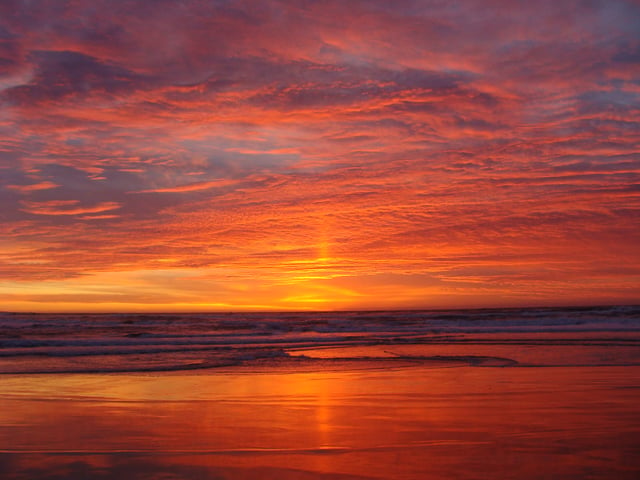
Sunset in Monterey County, California, U.S.
The volume of the Pacific Ocean, representing about 50.1 percent of the world's oceanic water, has been estimated at some 714 million cubic kilometers (171 million cubic miles).[54] Surface water temperatures in the Pacific can vary from −1.4 °C (29.5 °F), the freezing point of sea water, in the poleward areas to about 30 °C (86 °F) near the equator.[55] Salinity also varies latitudinally, reaching a maximum of 37 parts per thousand in the southeastern area. The water near the equator, which can have a salinity as low as 34 parts per thousand, is less salty than that found in the mid-latitudes because of abundant equatorial precipitation throughout the year. The lowest counts of less than 32 parts per thousand are found in the far north as less evaporation of seawater takes place in these frigid areas.[56] The motion of Pacific waters is generally clockwise in the Northern Hemisphere (the North Pacific gyre) and counter-clockwise in the Southern Hemisphere. The North Equatorial Current, driven westward along latitude 15°N by the trade winds, turns north near the Philippines to become the warm Japan or Kuroshio Current.[57]
Turning eastward at about 45°N, the Kuroshio forks and some water moves northward as the Aleutian Current, while the rest turns southward to rejoin the North Equatorial Current.[58] The Aleutian Current branches as it approaches North America and forms the base of a counter-clockwise circulation in the Bering Sea. Its southern arm becomes the chilled slow, south-flowing California Current.[59] The South Equatorial Current, flowing west along the equator, swings southward east of New Guinea, turns east at about 50°S, and joins the main westerly circulation of the South Pacific, which includes the Earth-circling Antarctic Circumpolar Current. As it approaches the Chilean coast, the South Equatorial Current divides; one branch flows around Cape Horn and the other turns north to form the Peru or Humboldt Current.[60]
Climate
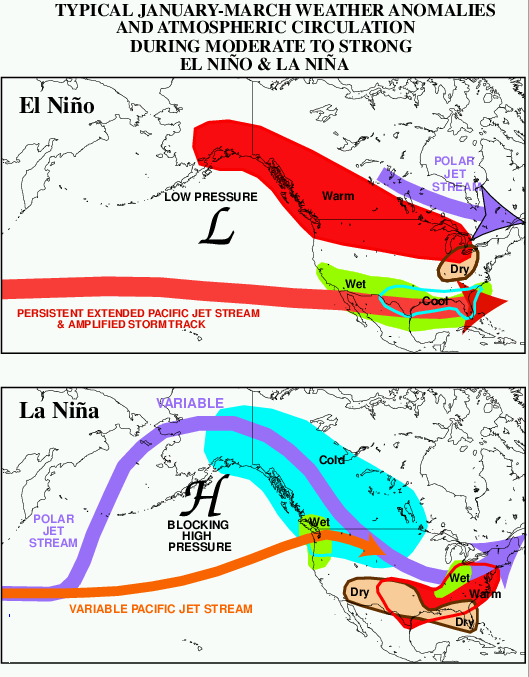
Impact of El Niño and La Niña on North America

Typhoon Tip at global peak intensity on 12 October 1979
The climate patterns of the Northern and Southern Hemispheres generally mirror each other.
The trade winds in the southern and eastern Pacific are remarkably steady while conditions in the North Pacific are far more varied with, for example, cold winter temperatures on the east coast of Russia contrasting with the milder weather off British Columbia during the winter months due to the preferred flow of ocean currents.[61]
In the tropical and subtropical Pacific, the El Niño Southern Oscillation (ENSO) affects weather conditions. To determine the phase of ENSO, the most recent three-month sea surface temperature average for the area approximately 3,000 km (1,900 mi) to the southeast of Hawaii is computed, and if the region is more than 0.5 °C (0.9 °F) above or below normal for that period, then an El Niño or La Niña is considered in progress.[62]
In the tropical western Pacific, the monsoon and the related wet season during the summer months contrast with dry winds in the winter which blow over the ocean from the Asian landmass.[63] Worldwide, tropical cyclone activity peaks in late summer, when the difference between temperatures aloft and sea surface temperatures is the greatest. However, each particular basin has its own seasonal patterns. On a worldwide scale, May is the least active month, while September is the most active month. November is the only month in which all the tropical cyclone basins are active.[64] The Pacific hosts the two most active tropical cyclone basins, which are the northwestern Pacific and the eastern Pacific. Pacific hurricanes form south of Mexico, sometimes striking the western Mexican coast and occasionally the southwestern United States between June and October, while typhoons forming in the northwestern Pacific moving into southeast and east Asia from May to December. Tropical cyclones also form in the South Pacific basin, where they occasionally impact island nations.
In the arctic, icing from October to May can present a hazard for shipping while persistent fog occurs from June to December.[65] A climatological low in the Gulf of Alaska keeps the southern coast wet and mild during the winter months.
The Westerlies and associated jet stream within the Mid-Latitudes can be particularly strong, especially in the Southern Hemisphere, due to the temperature difference between the tropics and Antarctica,[66] which records the coldest temperature readings on the planet. In the Southern hemisphere, because of the stormy and cloudy conditions associated with extratropical cyclones riding the jet stream, it is usual to refer to the Westerlies as the Roaring Forties, Furious Fifties and Shrieking Sixties according to the varying degrees of latitude.[67]
Geology

Ring of Fire. The Pacific is ringed by many volcanoes and oceanic trenches.
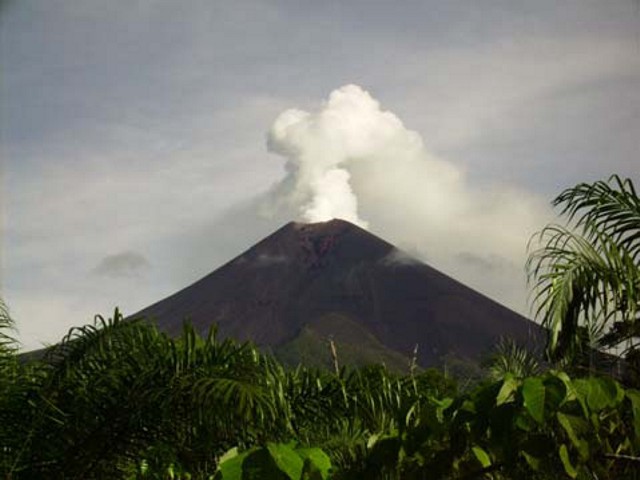
Ulawun stratovolcano situated on the island of New Britain, Papua New Guinea
The ocean was first mapped by Abraham Ortelius; he called it Maris Pacifici following Ferdinand Magellan's description of it as "a pacific sea" during his circumnavigation from 1519 to 1522. To Magellan, it seemed much more calm (pacific) than the Atlantic.[68]
The andesite line is the most significant regional distinction in the Pacific. A petrologic boundary, it separates the deeper, mafic igneous rock of the Central Pacific Basin from the partially submerged continental areas of felsic igneous rock on its margins.[69] The andesite line follows the western edge of the islands off California and passes south of the Aleutian arc, along the eastern edge of the Kamchatka Peninsula, the Kuril Islands, Japan, the Mariana Islands, the Solomon Islands, and New Zealand's North Island.[70][71]
The dissimilarity continues northeastward along the western edge of the Andes Cordillera along South America to Mexico, returning then to the islands off California. Indonesia, the Philippines, Japan, New Guinea, and New Zealand lie outside the andesite line.
Within the closed loop of the andesite line are most of the deep troughs, submerged volcanic mountains, and oceanic volcanic islands that characterize the Pacific basin.
Here basaltic lavas gently flow out of rifts to build huge dome-shaped volcanic mountains whose eroded summits form island arcs, chains, and clusters.
Outside the andesite line, volcanism is of the explosive type, and the Pacific Ring of Fire is the world's foremost belt of explosive volcanism.[47] The Ring of Fire is named after the several hundred active volcanoes that sit above the various subduction zones.
The Pacific Ocean is the only ocean which is almost totally bounded by subduction zones. Only the Antarctic and Australian coasts have no nearby subduction zones.
Geological history
Seamount chains
The Pacific Ocean contains several long seamount chains, formed by hotspot volcanism. These include the Hawaiian–Emperor seamount chain and the Louisville Ridge.
Economy
The exploitation of the Pacific's mineral wealth is hampered by the ocean's great depths.
In shallow waters of the continental shelves off the coasts of Australia and New Zealand, petroleum and natural gas are extracted, and pearls are harvested along the coasts of Australia, Japan, Papua New Guinea, Nicaragua, Panama, and the Philippines, although in sharply declining volume in some cases.[74]
Fishing
Fish are an important economic asset in the Pacific. The shallower shoreline waters of the continents and the more temperate islands yield herring, salmon, sardines, snapper, swordfish, and tuna, as well as shellfish.[75] Overfishing has become a serious problem in some areas. For example, catches in the rich fishing grounds of the Okhotsk Sea off the Russian coast have been reduced by at least half since the 1990s as a result of overfishing.[76]
Environmental issues
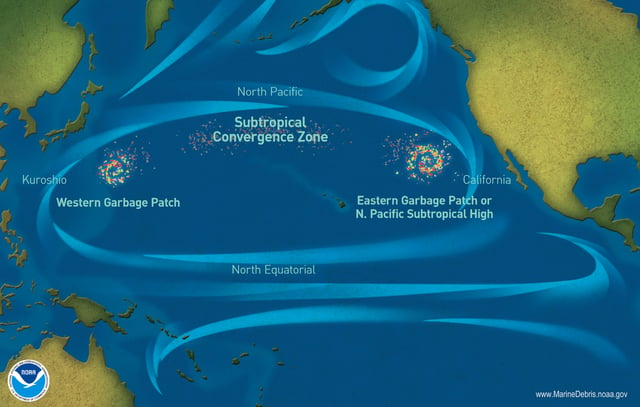
Pacific ocean currents have created 3 "islands" of debris.[77]
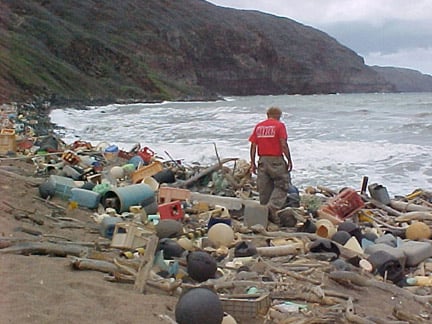
Marine debris on a Hawaiian coast
The quantity of small plastic fragments floating in the north-east Pacific Ocean increased a hundredfold between 1972 and 2012.[78] The ever-growing Great Pacific garbage patch between California and Japan is three times the size of France.[79] An estimated 80,000 metric tons of plastic inhabit the patch, totaling 1.8 trillion pieces.[80]
Marine pollution is a generic term for the harmful entry into the ocean of chemicals or particles.
The main culprits are those using the rivers for disposing of their waste.[81] The rivers then empty into the ocean, often also bringing chemicals used as fertilizers in agriculture. The excess of oxygen-depleting chemicals in the water leads to hypoxia and the creation of a dead zone.[82]
Marine debris, also known as marine litter, is human-created waste that has ended up floating in a lake, sea, ocean, or waterway. Oceanic debris tends to accumulate at the center of gyres and coastlines, frequently washing aground where it is known as beach litter.[81]
From 1946 to 1958, Marshall Islands served as the Pacific Proving Grounds for the United States and was the site of 67 nuclear tests on various atolls.[83][84] Several nuclear weapons were lost in the Pacific Ocean,[85] including one-megaton bomb lost during the 1965 Philippine Sea A-4 incident.[86]
In addition, the Pacific Ocean has served as the crash site of satellites, including Mars 96, Fobos-Grunt, and Upper Atmosphere Research Satellite.
Major ports and harbors
See also
Asia-Pacific Economic Cooperation
Pacific Alliance
Pacific coast
Seven Seas
Trans-Pacific Partnership
War of the Pacific
